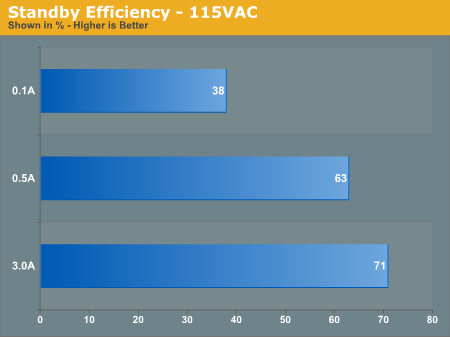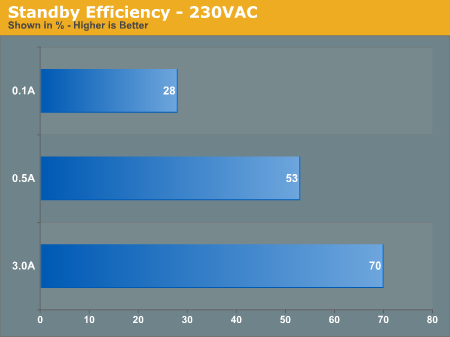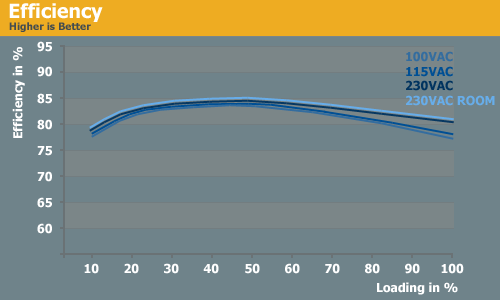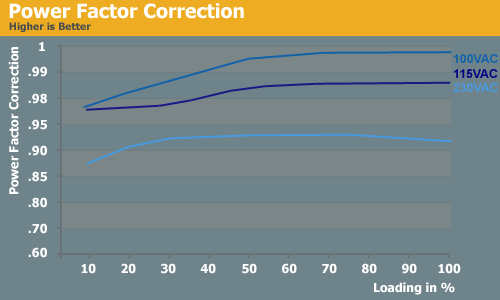Silver Power Blue Lightning 600W
by Christoph Katzer on August 27, 2007 6:00 AM EST- Posted in
- Cases/Cooling/PSUs
Standby Efficiency


The standby efficiency results are not particularly noteworthy, other than pointing out that power consumption is very low when there is no load placed on the power supply. We measured just 0.6W with 115VAC and 1.07W with 230VAC, which is a pretty good result.
Efficiency

When it comes to efficiency, the Blue Lightning 600W quite frankly blew our socks off. By all appearances, this is your everyday midrange power supply... we simply could not believe getting efficiency results as high as 85%! In fact, the efficiency is above 80% over almost the entire range which can not only save money on electrical costs but is also generally a good indicator of power supply quality. European users (and the other 230VAC countries) will get above 80% efficiency with loads ranging from 60W all the way up to 600W, while 115VAC users will get above 80% up until about 500W.
PFC

The Power Factor Correction was a bit unusual with this power supply. We're used to seeing nice curves at 100VAC and 115VAC, but the 115VAC doesn't rise as quickly as were used to seeing. It's only at 30% and above that the curve begins to rise, but then it stops again at around 60% load and stays at 0.986. 230VAC even starts to drop slightly at maximum load. This isn't an ideal result, but at the same time PFC isn't necessarily one of the most critical factors in determining power supply quality.


The standby efficiency results are not particularly noteworthy, other than pointing out that power consumption is very low when there is no load placed on the power supply. We measured just 0.6W with 115VAC and 1.07W with 230VAC, which is a pretty good result.
Efficiency

When it comes to efficiency, the Blue Lightning 600W quite frankly blew our socks off. By all appearances, this is your everyday midrange power supply... we simply could not believe getting efficiency results as high as 85%! In fact, the efficiency is above 80% over almost the entire range which can not only save money on electrical costs but is also generally a good indicator of power supply quality. European users (and the other 230VAC countries) will get above 80% efficiency with loads ranging from 60W all the way up to 600W, while 115VAC users will get above 80% up until about 500W.
PFC

The Power Factor Correction was a bit unusual with this power supply. We're used to seeing nice curves at 100VAC and 115VAC, but the 115VAC doesn't rise as quickly as were used to seeing. It's only at 30% and above that the curve begins to rise, but then it stops again at around 60% load and stays at 0.986. 230VAC even starts to drop slightly at maximum load. This isn't an ideal result, but at the same time PFC isn't necessarily one of the most critical factors in determining power supply quality.










33 Comments
View All Comments
Samus - Monday, August 27, 2007 - link
It appears that a log of people on newegg have this PSU fail after a few months. Now before we get into newegg consumer feedback 'reliability' :) there are a few people who've had these fail, not just one or two.I'm ganna give it a shot anyway. Should work well with my DFI Infinity 975 board, being EPS12v and all.
Slaimus - Wednesday, August 29, 2007 - link
Knowing it is an Apex-built power supply took most of the wind out of its sails. Apex, also known as L&C and Deer, has made some of the most unreliable power supplies ever.This seems to be one of their better efforts, but reliability will always be a concern with this company.
mindless1 - Thursday, August 30, 2007 - link
SMPS tech is reasonably mature beyond present tweaking a bit for higher efficiency, more 12V current, and these without cost rising out of control.Point being, Apex (actually better known as Foxconn or Hon Hai) can easily build quality PSU, it is not inability it is the choice of product placement and construction cost that results in some of the junk we've all seen.
As for reliability, there is a problem as always that you hear of someone with a failed PSU but no autopsy most of the time. No disrespect meant to reviewers, but over the years I can't could how many times a product seemed good at first glance, and second glance (a review period), but later a fault compromised the lifespan. A review of one unit can't take forever, it is going to be inherantly limited in scope, but still must be seen as a way to disqualify products more than qualify them for long term use.